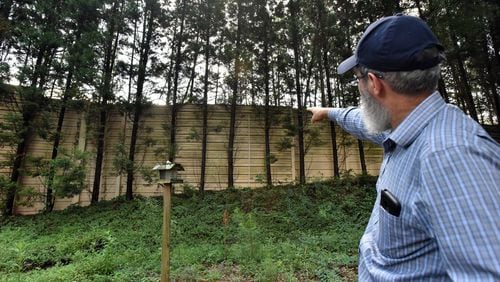Word spread through WhatsApp groups, email and over the phone: In Sandy Springs, a fence had come down during road construction. It needed to be reconstructed. Posthaste.
Immediately, Mendy Kessler swung into action, driving to Lowe’s to buy some plywood. It was only hours before the Jewish Sabbath. Among other prohibitions during the weekly observance, religious Jews are forbidden from carrying items outside the home from just before sundown each Friday through the completion of nightfall on Saturday.
If the fence was broken, so was a symbolic boundary that encircled Jewish neighborhoods — an eruv, which that allowed religious Jews to carry anything, from keys to kids, beyond their own front yard. The boundary is a modern adaptation of an ancient law makes it possible for people to carry in public spaces by turning them into private ones.
VIDEO: In other Fulton news
Kessler and others built a temporary connection using the plywood. But they also contacted the Georgia Department of Transportation, which had unwittingly removed part of the eruv during construction work at I-285 and Georgia 400 after committing to the Jewish community that it would work with them to keep it intact.
On that spring Friday, a public agency used to dealing with contracts and easements was forced to delve into the specifics of ancient Jewish law.
“Their sensitivity was just unbelievable,” said Beth Tefillah Rabbi Isser New, who called the department and asked if they could wait until Sunday to continue work that would remove more of the fence.
Much was riding on their cooperation.
On that particular weekend, Beth Tefillah was scheduled to host baby namings for two infants. Family members had traveled from out of town to mark the occasion. Without the eruv, the children couldn’t get to their own namings. Their mothers would have to stay home.
“I don’t want to say it was a Hail Mary, but we had nowhere else to go,” New said. “It would have been really sad if the families couldn’t go to their own celebration. Once (GDOT) heard what was going on, it felt like they cared to make it work, and that was unbelievable.”
GDOT is used to working around migratory birds, protected plant species, even Native American burial grounds. But an eruv?
“I’d never heard of this,” said Mark Edwards, the construction project manager on the project. “Every single person has been very curious, very interested. We didn’t know it existed.”
Edwards, a 32-year construction veteran, went home to Google the term. Now, he sounds conversant in the ancient Jewish practice. The eruv’s preservation has been added to a list of environmental commitments made for the duration of the project, which will last until 2020.
“It’s very important the line is all connected in the right place on the Sabbath,” said Butch Welch, the GDOT program manager. “Once we understood what (the rabbi’s) expectations were, it was very easy.”
There are two eruvim — that’s the plural — that use areas affected by the construction on Ga. 400 or I-285 as a boundary. Rabbis from two congregations estimated about 200 families used those boundaries to be able to carry tired children while they walk to services, push strollers or bring lunch to a neighbor’s house on Saturday afternoon.
The eruv itself is constructed out of fences, walls, telephone lines and other parts of the existing environment, with wire or fishing line used to connect areas to make a continuous circle. It’s invisible to someone who isn’t looking for the connections. Rabbis and volunteers check it weekly to ensure that it’s intact each Friday.
“You can think it’s kind of crazy. It doesn’t make sense to people who don’t understand Jewish law,” said Dovid Antopolsky, a Beth Tefillah member who coordinates the checking. “You build a virtual wall so you can carry on Saturday?”
But the boundary can make a huge difference in the lives of residents.
Before they lived inside the eruv, Yocohnon and Rozi Goldman went to great lengths to get their then-3-year-old daughter, Chana, to Saturday morning services. They bought a $20 stroller from Target and hid it in the bushes right inside the eruv’s boundary. Then they coaxed Chana to walk the quarter mile until she was inside the boundary, and they could lift her into the stroller. If she didn’t want to walk anymore, they waited until she was willing. They could hold her hand to guide her, but they couldn’t pick her up to carry her until they were inside the eruv.
When word spreads that the eruv might be down, Rozi Goldman said, “We all get a pit in our stomachs.” It can be a huge disruption. Religious Jews are also prohibited from cooking on the Sabbath. So, if they can’t get to the synagogue to eat lunch, as they often do, it could mean a hungry family, stuck at home.
“It’s nerve wracking,” Rozi Goldman said. “It’s a very big thing for us.”
Joshua Heller, the senior rabbi at Congregation B’nai Torah in Sandy Springs, compared the eruv being down to a power outage.
“You can live without it for a while, but at some point, it gets in the way of living the life you want to live,” he said. “It’s definitely been a little bit of a source of stress around here.”
What is an eruv?
An eruv is a boundary that symbolically encloses a Jewish community, extending private areas into public space. Within an eruv, people are allowed to carry objects on the Sabbath, an activity that is normally prohibited outside of one’s own home. There are two eruvim — that’s the plural — near the I-285/Ga. 400 construction site that use fences, telephone poles, sound barrier walls and wire connections to create a boundary around a community.
About the Author








